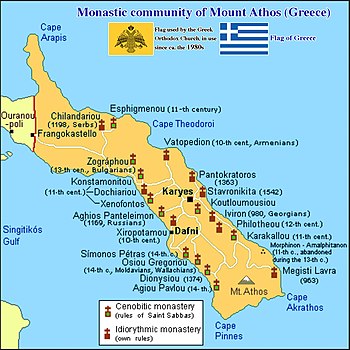Footpaths of Mount Athos
Mount Athoshas an extensive network offootpaths,many of which date back to theByzantine period.These paths are typically trails designed for human foot traffic and mules, and are not wide enough for motor vehicles. They connect the variousmonasteries,sketes,cells,kathismas,andhermitageson the peninsula to each other.[1][2]
History
[edit]Many of the footpaths of Mount Athos date back to the Byzantine period. Some are cobblestone paths (kalderimi), while most are dirt trails (monopatia).
Starting in the 1960s, many of the footpaths began to fall into disrepair. However, in the 21st century, theFriends of Mount Athosand other volunteers have been restoring and maintaining the footpaths for pilgrims and monks to use.[3]Today, most of the footpaths are signed, well maintained, and in good condition. The Friends of Mount Athos footpath group also maps outGPX filesfor the footpaths and monitors their conditions.[1][4]
Eastern coast
[edit]
From north to south in order, the footpath network on the eastern coast of the Athonite peninsula takes pilgrims through the following sites.[1]
- Helandariou Monastery(interior)
- Esphigmenou Monastery
- Vatopedi Monastery
- Agiou Dimitriou Skete(interior, behind Vatopedi)
- Bogoroditsa Skete(interior, behind Pantokratoros)
- Pantokratoros Monastery
- Skete of Prophet Elijah(interior, behind Pantokratoros)
- Stavronikita Monastery
- Kapsala(interior, behind Stavronikita)
- Koutloumousiou Monastery(interior, behind Karyes)
- Skete of Saint Andrew(interior, behind Karyes)
- Skete of Saint Panteleimon(interior, behind Koutloumousiou)
- Iviron Monastery
- Skete of Timiou Prodromou Iviron(behind Iviron)
- Mylopotamos
- Filotheou Monastery(interior)
- Karakalou Monastery(interior)
- Provata(interior)
- Morfonou(port with ferry service)
- Lakkoskiti(interior, behind Morfonou)
- Great Lavra Monastery
Western coast
[edit]From north to south in order, the footpath network on the western coast of the Athonite peninsula takes pilgrims through the following sites. The western coast is steeper and more rugged than the eastern coast.[1]
- Zografou Monastery(interior)
- Konstamonitou Monastery(interior)
- Docheiariou Monastery
- Xenophontos Monastery
- Evangelismou tis Theotokou
- Agiou Panteleimonos Monastery
- Xeropotamou Monastery
- Dafni(port with ferry service)
- Simonos Petras Monastery
- Osiou Grigoriou Monastery
- Dionysiou Monastery
- Agiou Pavlou Monastery
- New Skete
- Skete of Saint Anne
- Vouleftiria
- Little St. Anne's Skete
- Karoulia(port with ferry service)
- Katounakia
Southern coast
[edit]The rugged southern coast, which forms the southern slope of the main summit of Mount Athos, is also known as theDesert of Mount Athos,a reference to theScetis Desertwhere Christian monasticism had originated.Hesychasthermits have traditionally lived in this area.
From east to west in order, the footpath network takes pilgrims through:[1]
- Great Lavra Monastery
- Prodromos
- Vigla
- Chairi (Χαΐρι) Pass; the Cave ofPeter the Athoniteis located in the Chairi area[5]: 71
- Megali Sara (Μεγάλη Σάρα; ascree,or hillside covered by rocks)
- Agios Nilos
- Agias Triados Skete(Kafsokalyvia,which has a port with ferry service)
- Kerasia(interior)
- Skete of St. Basil(interior)
- Katounakia
- Karoulia(port with ferry service)
Way of the Bey
[edit]The Way of the Bey (Greek:Μονοπάτι της ΚορυφογραμμήςorΔρόμος του Μπέη) primarily runs along the Athos peninsular ridge. It starts fromEsphigmenou Monastery,reaches its highest point at the peak ofAntiathonas(1042 m), and ends atDionysiou Monastery.[6]
See also
[edit]Bibliography
[edit]- Howorth, Peter (2022).Mount Athos: The Holy Mountain.Filathonites.ISBN978-0-473-41386-6.(a detailed multilingual map of Mount Athos in English, Greek, and Russian; also contains notes in German, French, Italian, Serbian, Bulgarian, and Romanian)
- Thomas, Chris and Howorth, Peter (2022).Encounters on the Holy Mountain.ISBN978-2-503-58911-4.(stories from Mount Athos)
References
[edit]- ^abcde"Footpaths of the Holy Mountain – FOMA".FOMA.2019-01-06.Retrieved2022-06-16.
- ^"Mount Athos Footpaths".Monastiriaka.Retrieved2022-06-20.
- ^Speake, Graham;Ware, Kallistos(2012).Mount Athos: Microcosm of the Christian East.Oxford: Lang, Peter, AG, Internationaler Verlag der Wissenschaften.ISBN978-3-0353-0233-2.OCLC823378976.
- ^Footpaths of the Holy Mountain: Table of footpaths with conditions, walking times & links to descriptions and GPS tracks(Version 5.0).Friends of Mount Athos,September 2020. Retrieved 15 June 2022.
- ^Lilios, Loukas K. (2017).Mount Athos: Pilgrimage to "The Garden of Virgin Mary".Translated by Konstantina, Vlachoutsakou. Livadia: Lilios Publishers.ISBN978-618-81848-6-2.
- ^Howorth, Peter; Thomas, Christopher; Baetens, R.; Charles, Prince of Wales (2020).Encounters on the Holy Mountain: stories from Mount Athos.Turnhout, Belgium.ISBN978-2-503-58911-4.OCLC1196244710.
{{cite book}}:CS1 maint: location missing publisher (link)
External links
[edit]- Mount Athos pilgrim mapsfrom Filathonites.org
- AllTrails
- Avenza Maps
- Suggested routes for pilgrims

